Open innovation is a model in which companies look beyond their walls for innovative ideas by calling on customers, research institutions, external partners, startups, and students, among others, and by actively commercializing their own under‑used inventions—licensing, spinning off, or selling those technologies to outside organizations to create additional value.
Because companies tap into a wider range of perspectives, they are typically better equipped to protect against disruption and strengthen their competitive advantage than those that rely solely on employee ideas.
That said, as innovation consultants for over 15 years, we've seen companies repeatedly make the same avoidable mistakes that prevent them from realizing value from open innovation initiatives. Specifically, they put all their effort into collecting ideas but don’t set up the proper structures to filter, de-risk, and implement them.
To help companies not just collect outside ideas but actually move them through the innovation funnel, we wrote this guide on implementing open innovation. We discuss innovation practices, how to avoid common mistakes, and the tools and systems required to manage innovation at scale.
We also cover how our innovation management platform, InnovationCast, enables companies to implement open innovation systems in less than four weeks.
Book a quick demo to learn how InnovationCast can help you establish an open innovation program.
Step 1: Develop an Innovation Strategy Detailing the Priorities You Want to Address with Open Innovation
The first thing we always recommend companies do before launching any new innovation initiative is to create an innovation strategy.
An innovation strategy details the problems and priorities you want to address through innovation. The strategy should be aligned with the company’s strategic direction, so that innovation serves its needs and objectives. It’s a service that improves the company’s bottom line, like marketing, R&D, and IT.
Since developing an innovation strategy is a topic in itself, we’ve created a guide you can read here.
Our main advice around creating open innovation strategies is to engage all key stakeholders (e.g., the product team, the CEO in smaller companies, the R&D team), learn about their priorities, sort them from most to least impactful, and create a document outlining them.
Then, specify the target audience for each priority, such as customers, startups, researchers, or students — those best equipped to address them.
The following is an example of how Brisa, an InnovationCast client, structured its innovation strategy:
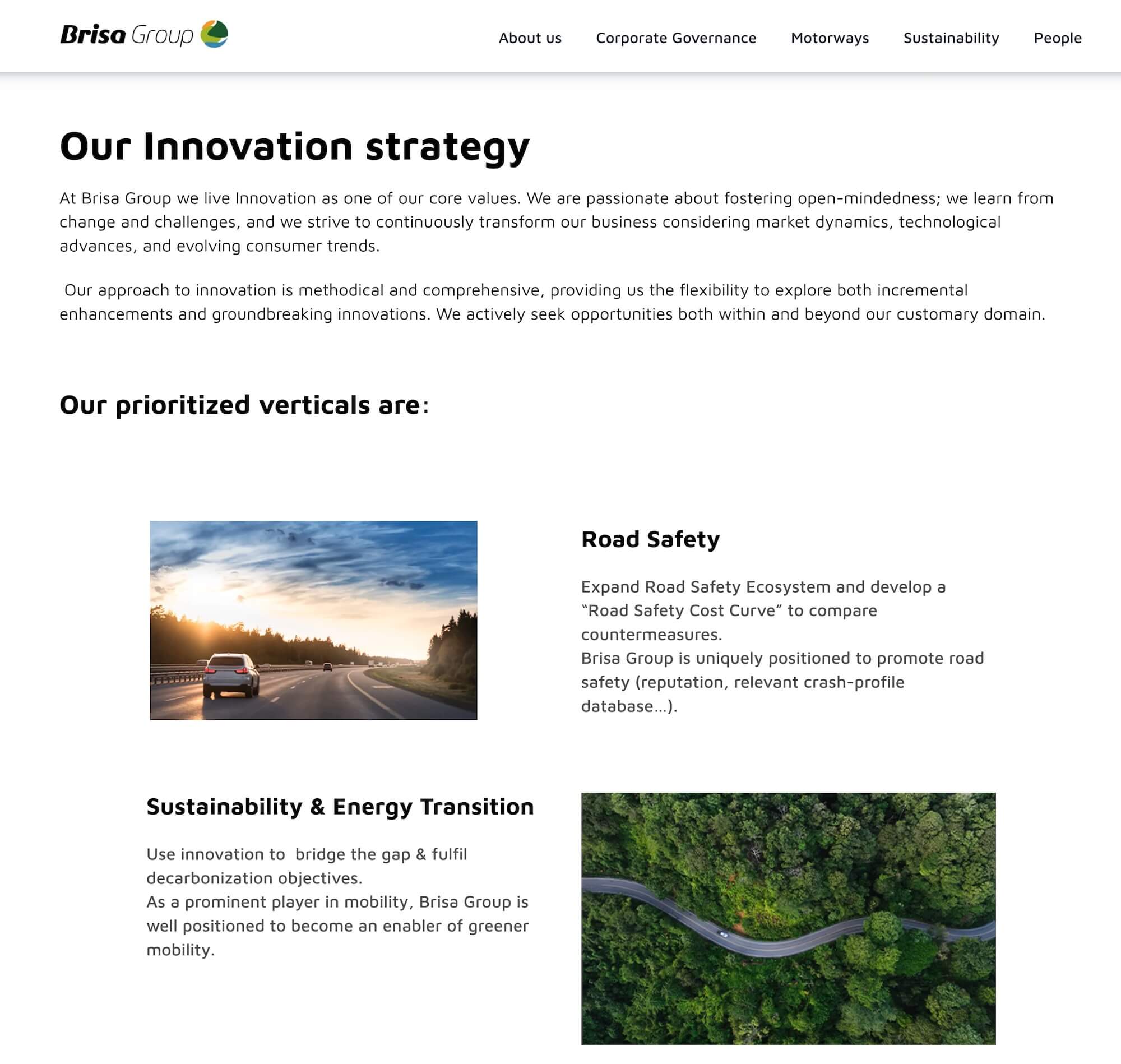
By clarifying the priorities that drive the most value for the company, innovation managers can focus outside participants on them. The subsequent results show top management that innovation is generating ROI.
Additionally, the strategy should be flexible and change as new opportunities and threats emerge. This creates a feedback loop between innovation managers and outside participants. If something disruptive pops up that impacts the company and top management is unaware of it, the company can change its strategy to reflect this.
Read more: ISO 56000 Explained: A Comprehensive Guide
Step 2: Gather Ideas Related to Each of the Priorities in the Innovation Strategy
Once you’ve created a strategy document, we recommend crowdsourcing external ideas by publishing Innovation Challenges for each priority in the strategy.
Innovation Challenges are time-bound invitations detailing the specifics and nuances of a specific priority and asking participants to share ideas, solutions, and proposals. Here’s an example of Brisa launching a challenge on worker safety in work zones:
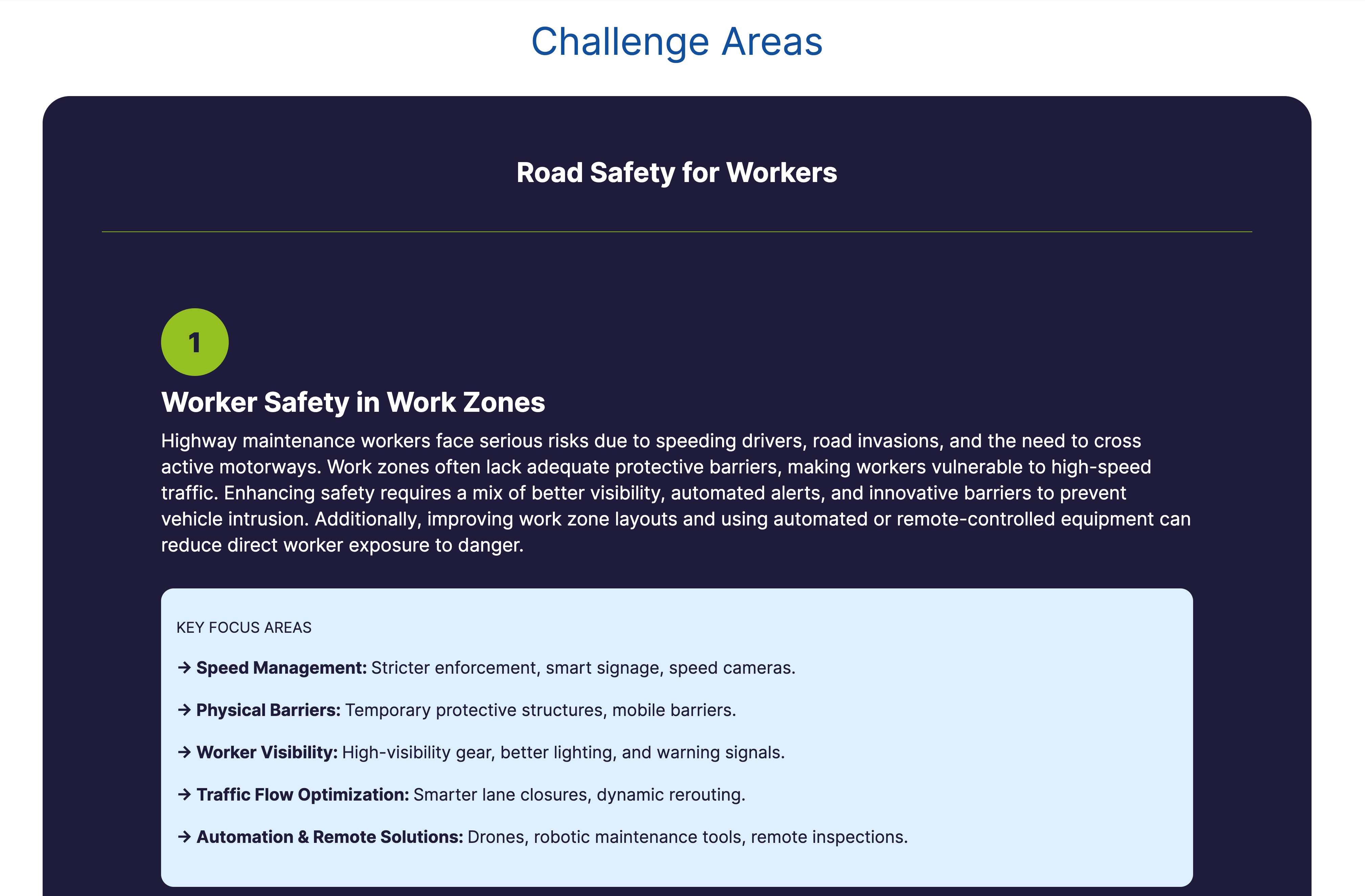
Innovation participants can study your priorities and share ideas on addressing them.
To encourage employees to surface new opportunities and threats not in the innovation strategy, we found that open idea boxes can work well. However, the idea box should still have loose guidance on the kinds of ideas required. This way, participants aren’t sharing irrelevant ideas that companies inevitably toss out.
For example, another InnovationCast client, Global Water Innovation Platform (GWIP), has an idea box open on their website where participants can share broader ideas on each of these five areas:
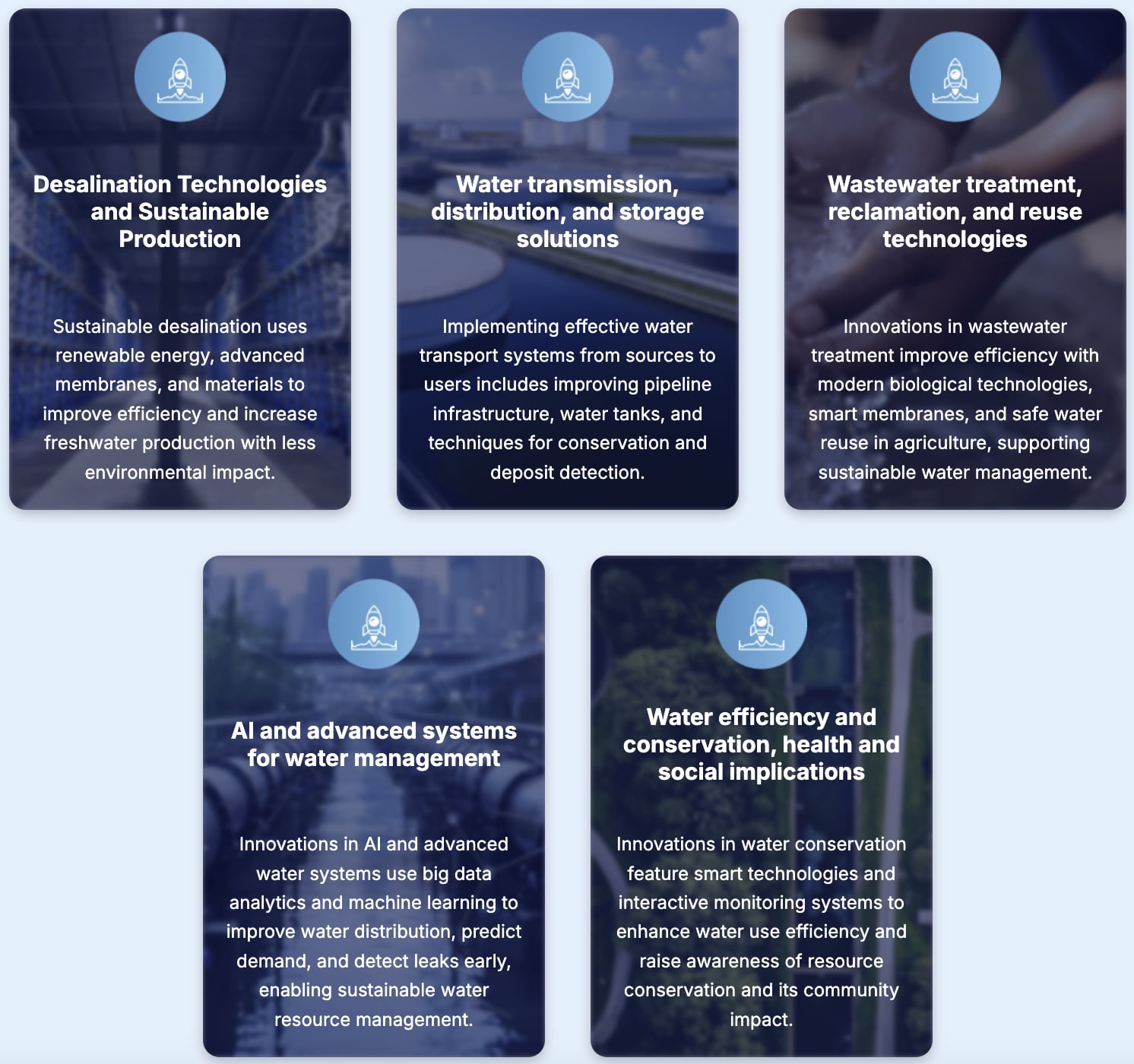
Read more: 5 Detailed Innovation Challenge Examples & Best Practices
How InnovationCast Supports Targeted Idea Collection
During onboarding, we will learn about your company’s priorities and help you develop an innovation strategy. We tie innovation efforts to business goals, so you achieve actual ROI from innovation.
Then, we design high-quality Innovation Challenges using what we learned about your priorities. Unlike most innovation platforms, you don’t have to create these postings on your own.
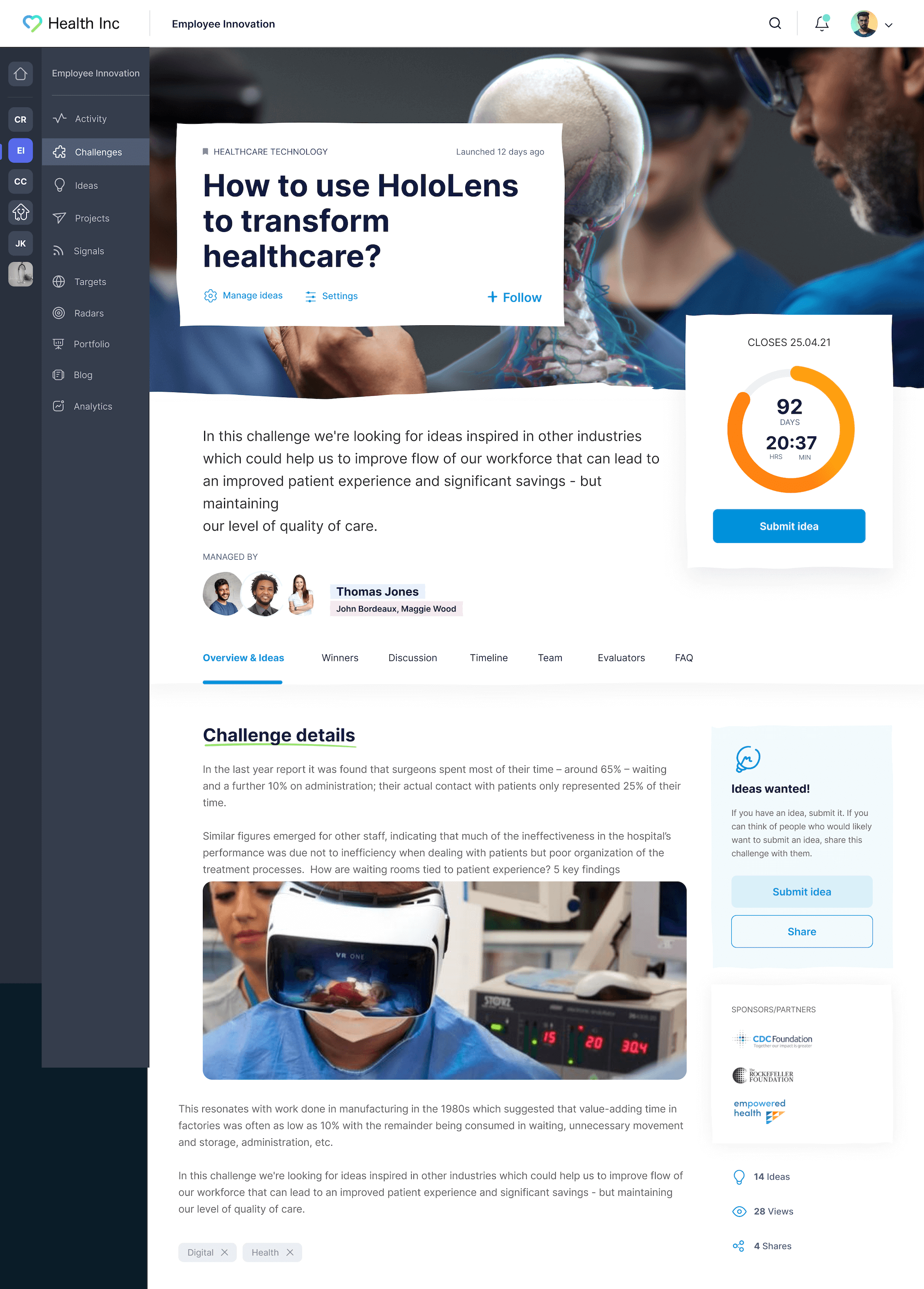
We also utilize our network of startups, researchers, universities, and subject matter experts to review the challenge and contribute new ideas, new technologies, and innovative solutions (more on this below).
As participants share ideas, they can view its progress inside the InnovationCast dashboard; they can see whether it’s in refinement, evaluation, validation, or implementation. If evaluators need iterations, they receive a notification. This transparency keeps them engaged and shows that their hard work isn’t going to waste. You don’t get this with a Google Form or spreadsheet.
We also designed InnovationCast with an “Always On” feature where outside participants can share ideas on topics not relevant to current challenges but impact the company in some way. However, you can still limit idea submissions to certain areas of interest. For instance, here we can see a healthcare company limiting “Always On” submissions to four topics:
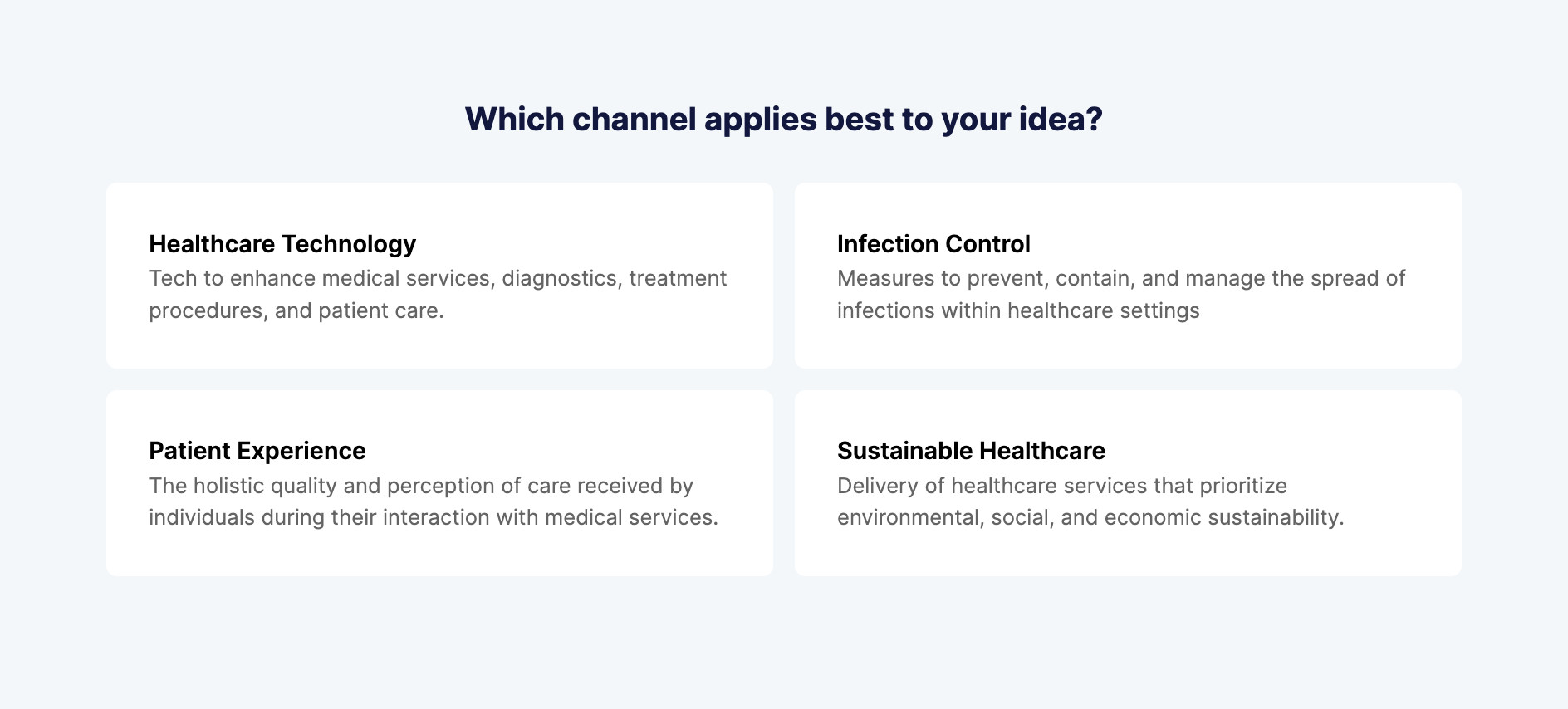
Read more: 5 Best Open Innovation Platforms + Reviews
Step 3: Spark Engagement Around the Priorities You’re Tackling
With internal innovation, there’s usually an existing mechanism for reaching employees, such as an intranet system or Slack channel.
However, with open innovation, your audience is outside the company. You need to find them, get them to learn about your challenge, submit high-quality ideas, and keep them engaged as ideas progress through the workflow.
If you’re a household name like Coca-Cola or Procter & Gamble, generating interest from your target audience is simple. Create a challenge, publish it on your website and social media, and you’ll get thousands of participants sharing ideas.
However, lesser-known brands need to develop a marketing plan and create awareness of their priorities. Many companies run social media ads about their challenges, email customers to get involved, or engage scouts to look for relevant startups.
A key factor to consider when marketing your challenge is the timeframe. Setting strict deadlines is essential to engaging external innovators; otherwise, they may procrastinate. However, you should run shorter or longer challenges depending on your brand's size.
Big brands can drive innovation and get so many ideas within a short period that they can run a challenge for five days, for example, and have all the ideas they need. However, the smaller your brand and the less engagement you can drum up, the longer you’ll need to keep your challenge live.
With an effective marketing plan, many lesser-known brands can collect a large number of ideas within four weeks.
InnovationCast’s Scouting Partnerships Enable You to Get a Lot of Participants Sharing Ideas within a Short Period of Time
To help companies build buzz around their Innovation Challenge without developing a marketing plan from scratch, InnovationCast can engage scouts who will identify relevant startups, researchers, and other external participants and encourage them to submit proposals.
These full-time scouts learn about the priorities, initiatives, and problems you want to address. They scour through vast databases looking for startups and participants who can tackle these issues and invite them to apply.
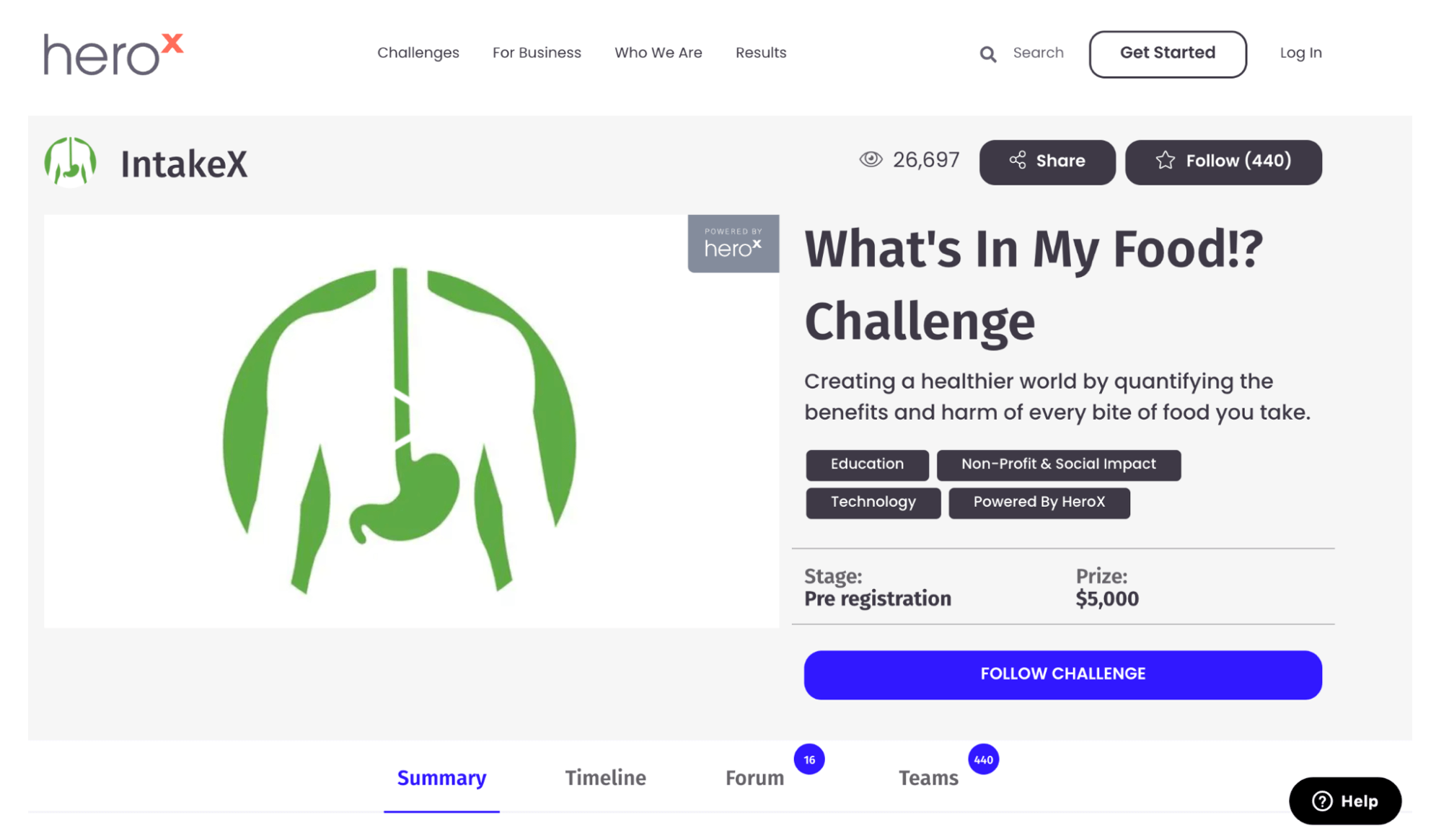
Outside participants can log into your InnovationCast dashboard, explore your priorities, and submit customized proposals showcasing how their solution fits.
Once startups submit proposals, they can follow their journey through workflow stages, communicate with evaluators, iterate upon their ideas, and get notified of any messages or comments.
All communication and shared media between your company and startups — such as chats, meeting notes, edits, and video calls — are organized within the idea thread for convenient access.
Read more: How to Encourage Innovation in the Workplace | InnovationCast
Step 4: Refine Concepts by Having Employees and Outside Participants Co-create
The steps following idea generation will vary depending on the competitiveness of your challenge.
For challenges where outside participants like startups compete for a contract and the company can choose only one solution, the innovation process is closed with little co-creation. Proposals are submitted and evaluated independently.
However, for non-market-driven challenges, perhaps customers sharing product ideas, we found that having participants co-create and build on top of each other’s ideas improves quality.
Co-creation and external collaboration are necessary when working on breakthrough initiatives, such as developing new products or entering new markets. It’s rare for one author to conceive and fully refine these complex ideas alone. They need to pull insights from customers, employees, investors, and other stakeholders to refine their ideas, sometimes over months or years, before they can be implemented.
However, we’ve seen that most companies don’t have the systems to co-create solutions. They collect ideas using tools like Google Forms, survey apps, and spreadsheets, which lack transparency and don’t provide participants with a way to work with others.
We emphasized co-creation when designing InnovationCast.
The InnovationCast Activity Dashboard Enables Co-Creation and Collaboration
When running non-competitive challenges, companies can choose to display ideas on the InnovationCast activity feed for others to see when signing in.
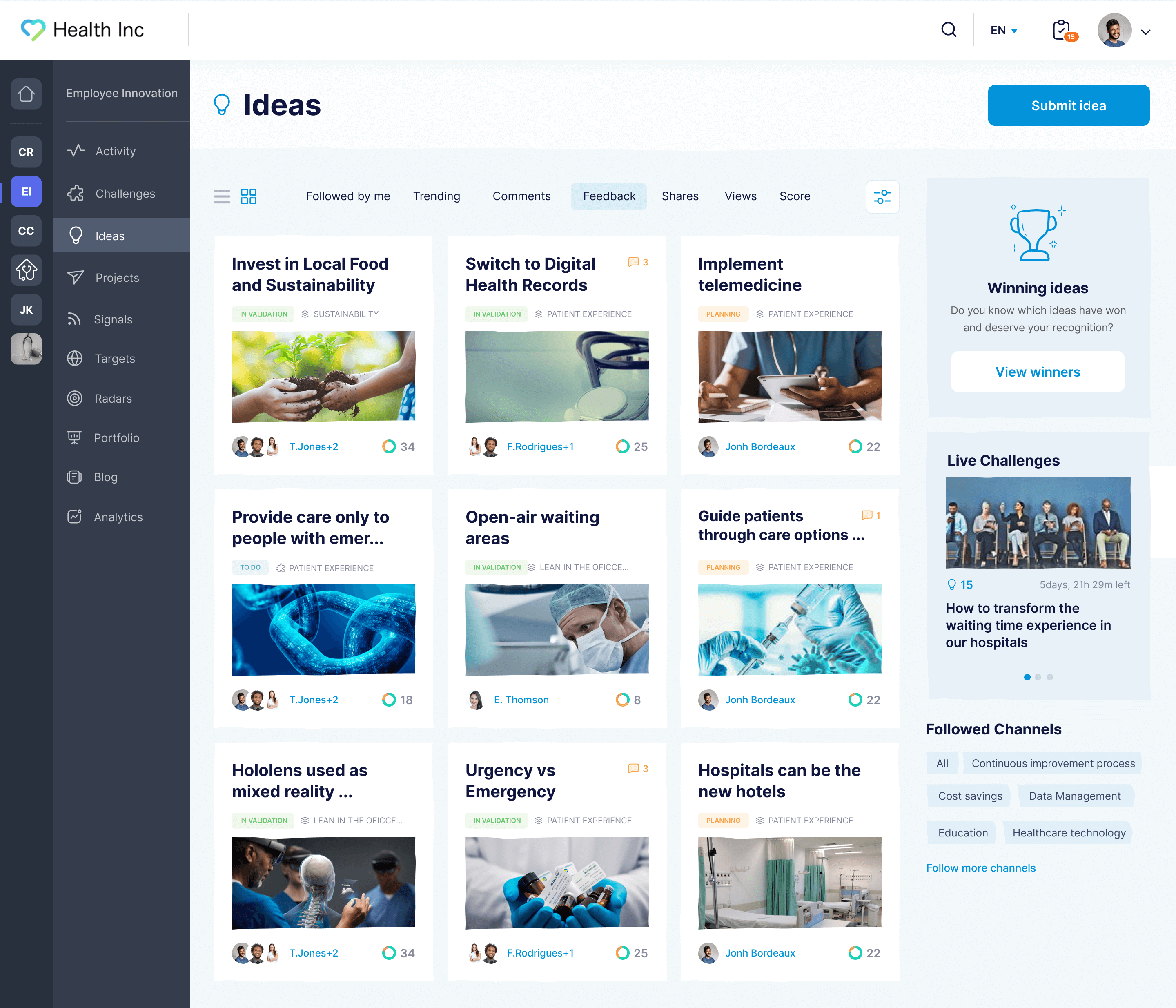
InnovationCast uses subtle features such as email nudges and voting to encourage users to co-create with the idea author. Users can give an idea a thumbs up, a thumbs down, or say whether they are undecided. Then, InnovationCast requires them to provide feedback to the author.
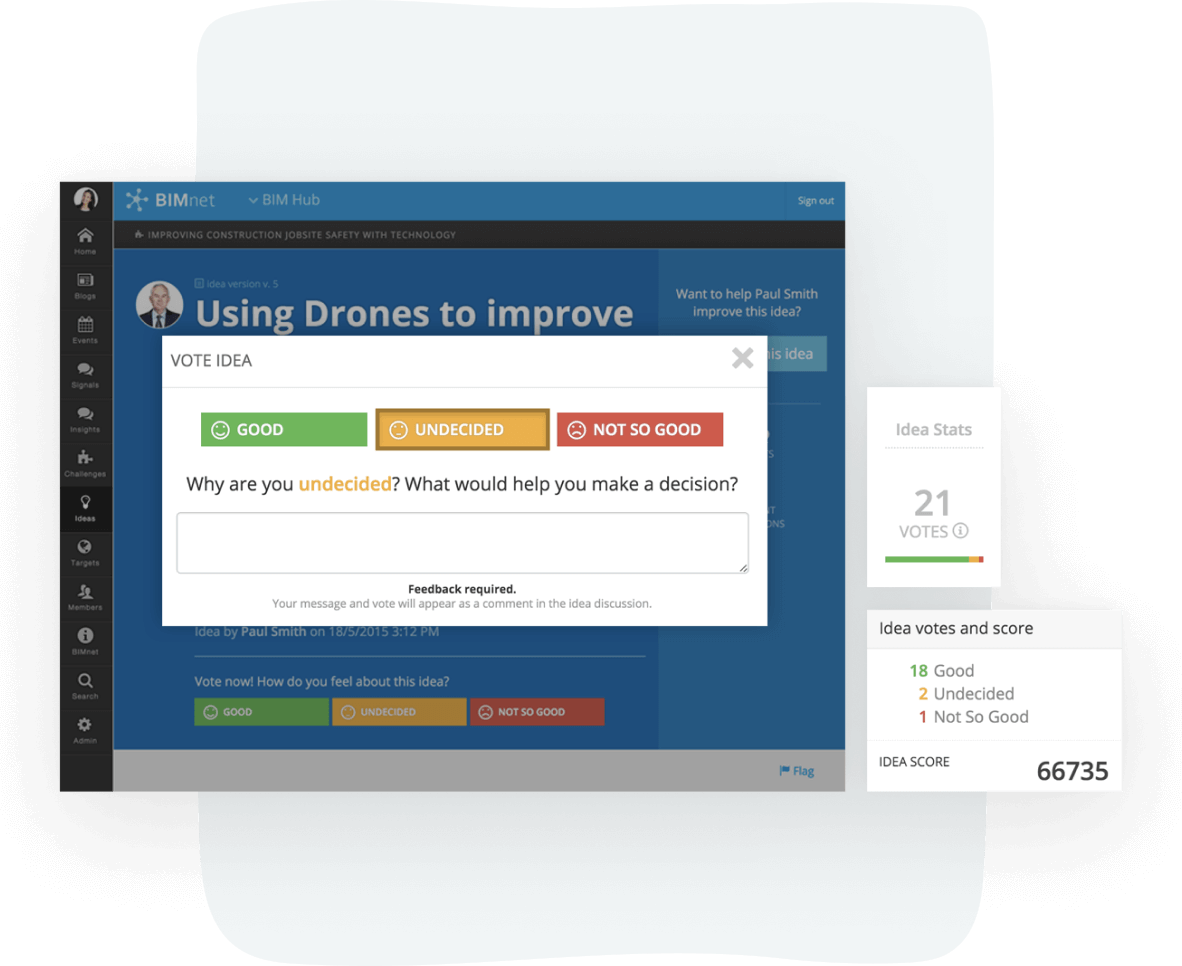
This essentially allows authors to improve their ideas by tapping into the opinions, perspectives, and skill sets of employees, customers, engineers, researchers, and others.
As idea authors and co-creators refine ideas, InnovationCast automatically tracks each version so stakeholders can easily see how the idea changed and which feedback led to improvements.
Idea authors can also tag impactful feedback with a "Significant Contribution,” crediting co-creators with shaping the idea.
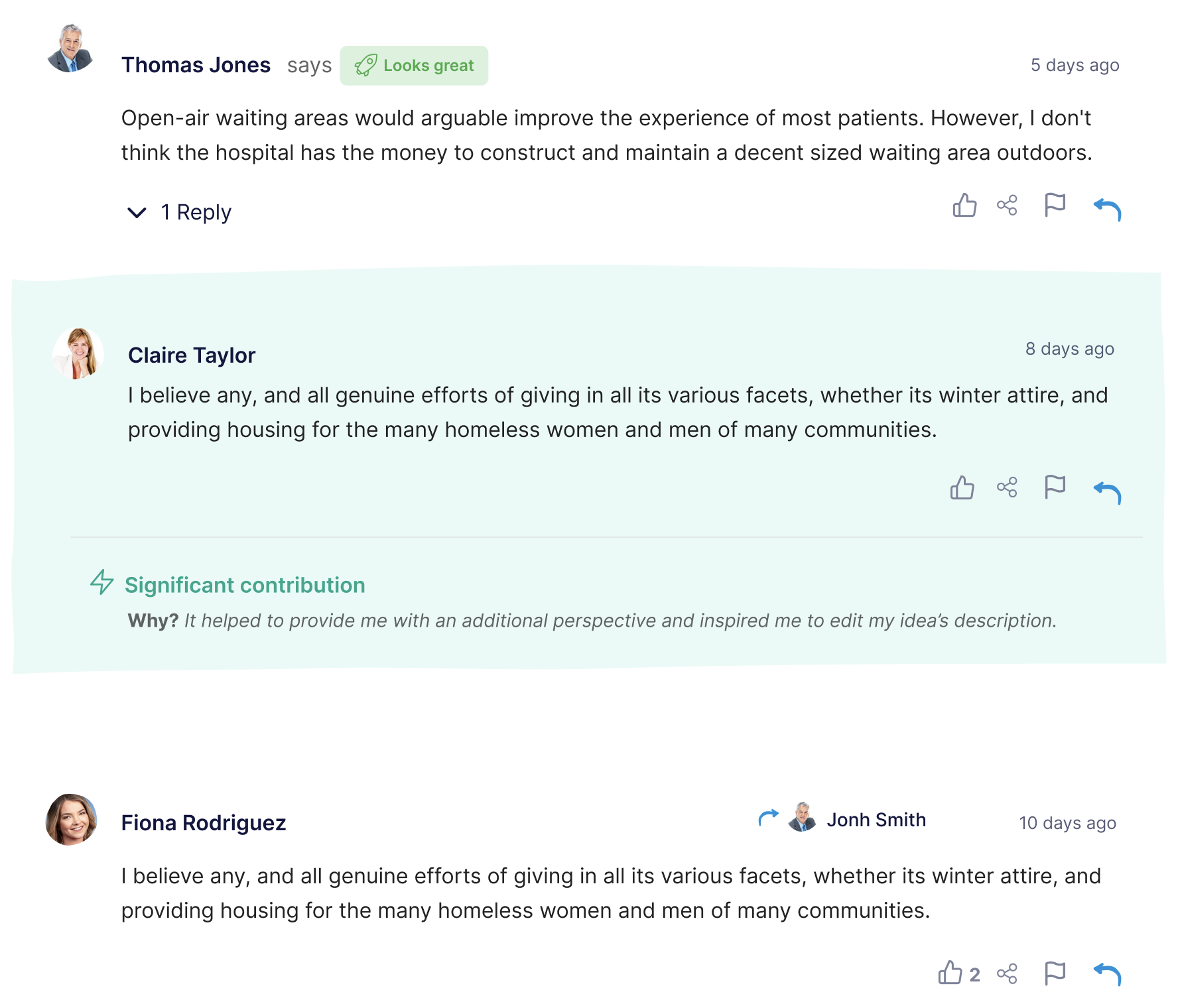
We also offer strong intellectual property (IP) protection features designed for companies that want employees and external sources to collaborate without compromising their IP.
Step 5: Evaluate, Select, and Prioritize the Best Ideas
Once ideas are collected, they are typically sent to a subject matter expert for evaluation. For example, if a paint company asks for ideas to make their paint smoother, those ideas may go to the head of engineering.
The mistake we see companies make after idea generation is failing to establish the systems and workflows to evaluate, validate, implement, and realize value from ideas.
Remember, with open innovation, you’re sourcing ideas at a larger scale than closed innovation. So, you need the systems to manage this process at scale. This is the biggest reason why open innovation models fail within most companies.
When companies lack the systems to advance ideas, they not only fail to capture the benefits of open innovation, but that failure also becomes visible to the outside world. Customers, startups, and outside participants share their best ideas, never hear back again, and get frustrated.
Teams may try to piece together a post-ideation process using ad hoc tools like email, forms, and spreadsheets, but this often results in them falling into the communication trap. They have to manually send emails notifying each participant of whether they are successful. When ideas need iteration, they have to write emails detailing what needs to be changed.
This back-and-forth with outside participants ends up being the biggest drain on time.
Read more: 10 Best Practices for Fostering a Culture of Innovation
InnovationCast Workflows Guide the Evaluation Process and Streamline Repetitive Tasks
InnovationCast can automate the post-ideation process based on your needs on a micro level, from button actions to visibility settings, workflow rules, and more.
For example, evaluators can simply click a button, and the participant is automatically notified of their idea’s status. If ideas need refinement, evaluators can click a button, give feedback on what needs improvement, and the participant is notified. This enables companies to manage hundreds of open-source ideas with minimal time and effort.
Additionally, we have configurable workflows that guide the evaluation (and validation) process, with scoring systems and evaluation models for different kinds of ideas. We have workflows for product development ideas, new business model ideas, sustainability ideas, process improvement ideas, and more.
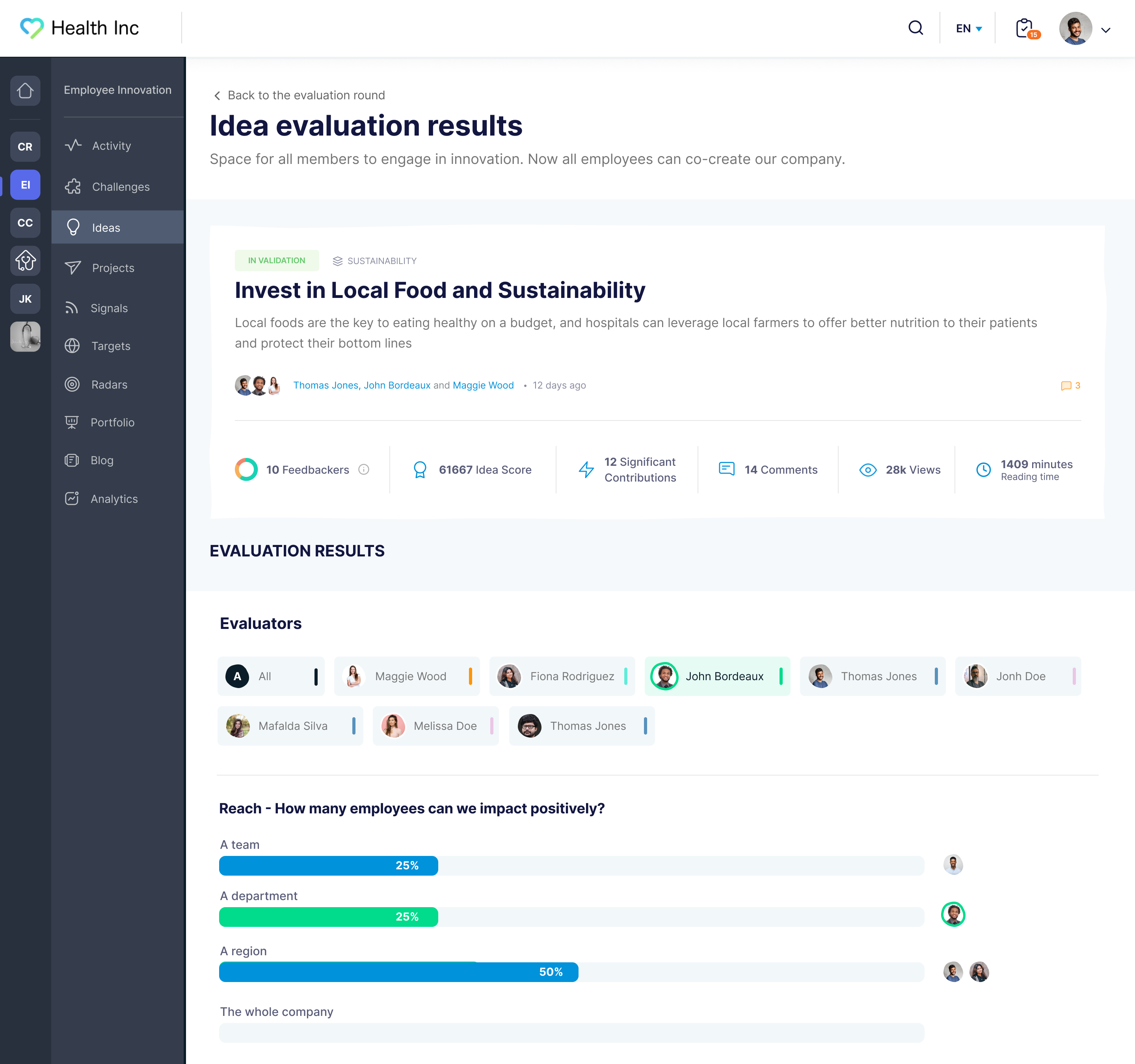
During onboarding, we learn about your priorities and types of open innovation ideas you need, using that information to tailor workflows around those considerations.
For example:
If you expect evaluators to request frequent revisions due to the complexity of the problem, we can design a button that automates this, eliminating the need to send manual emails.
If your team wants to encourage cross-collaboration only for specific ideas, we can configure the platform to make certain submissions visible to others, enabling threaded comments, upvotes, or editable suggestions.
If you prefer to keep ideas private until they pass a certain threshold (like a score or stage), we can lock visibility until that point.
We also paid special attention to making InnovationCast configurable with clicks rather than code so administrators can adjust workflows, forms, categories, and other settings without IT support.
Step 6: Validate High-Risk, High-Uncertainty Ideas
Another component of structuring the post-ideation process is defining clear workflow stages for de-risking high-risk, high-uncertainty ideas.
For example, if multiple customers recommend launching a new and innovative product, top management will see that there are many risk factors surrounding the idea’s success — customer demand, technical feasibility, pricing — and will not want to pour resources into a full implementation before reducing some of those risks.
During validation, the goal is to mitigate potential risks before committing resources to full-scale implementation.
To do this, validation teams will determine factors or assumptions that must be true for an idea to succeed, and run experiments to test them. Based on those results, top management will either fund the implementation or table the innovation.
For example:
Assumption: Premium customers are willing to pay extra for same-day delivery.
Experiment: Offer same-day delivery as a limited-time pilot to a segment of premium users and track sales.
Assumption: Users with wrist pain prefer this keyboard over their current one.
Experiment: Conduct a usability test with target users, tracking comfort ratings and willingness to switch after a week.
Assumption: A scouted startup offers a paint that can improve visibility for drivers.
Experiment: Test paint samples under controlled lighting conditions and measure reflectivity.
We won’t go into too much detail on validating ideas because we have an entire article on that, which you can read here.
However, the most common mistakes we see companies make during the validation stage are:
They provide no guidance for the validation team: Validation teams aren’t innovation managers and rarely know how to manage innovation projects. Innovation managers should create workflows that act as guidance on mapping assumptions, designing experiments, choosing and tracking risk factors, and so on.
Stakeholders cannot view the innovation portfolio: Each team validates ideas using their own tools, making it difficult for stakeholders to access results, see experiment outcomes, or understand which ideas to fund or deprioritize. As a result, stakeholders default to thinking no progress is being made and cut innovation funding.
InnovationCast Workflows Bring Structure to the Validation Process
InnovationCast workflows guide teams through the validation of different kinds of ideas.
This includes guidance on mapping assumptions, selecting experiments, identifying key risks, prototyping, and more. We have tools like assumption mapping templates, experiment design guides, and risk prioritization matrices to help with this.

Additionally, InnovationCast workflows automate the administrative work involved with managing innovation projects.
For example, when someone is finished validating their assumption, InnovationCast notifies the person responsible for de-risking the next one. If a risk outcome meets predefined criteria, it can automatically trigger a status change, update visibility settings, or prompt a review cycle — no manual follow-up required. This ensures innovation projects don’t stall.

Then, as experiments run, InnovationCast aggregates results inside the reporting dashboard for stakeholders, sponsors, and other decision-makers to see. This is essential for maintaining a long-term budget for innovation efforts.

Step 7: Call on the Project Management Office to Implement Ideas
The innovation department, idea authors, or validation teams usually don't have responsibility for implementing ideas. Once validation teams de-risk ideas and top management deems projects worth investing in, the project management office (PMO) takes responsibility for implementation.
Idea implementation is typically done in-house and involves turning validated concepts into innovative solutions. The PMO maps action plans, allocates resources, assigns ownership, and integrates the idea into existing workflows or systems.
The only exception to this — where innovation teams collaborate closely with the PMO — is when an idea carries significant risk and requires continued discovery and validation, even during implementation.
For example, when Google launched Google Glass — a bold and revolutionary concept — the product ultimately struggled in the real world. Privacy concerns, unclear use cases, and social resistance revealed just how much discovery was still needed after launch.
In such cases, implementation isn't the end of innovation. The innovation department will continue to work closely with internal resources like the PMO and internal R&D (research and development) during implementation to learn more about the idea and reduce risk.
Implement a Successful Open Innovation Ecosystem within Your Organization with InnovationCast
Discover how InnovationCast can help establish an effective open innovation process in less than four weeks.

